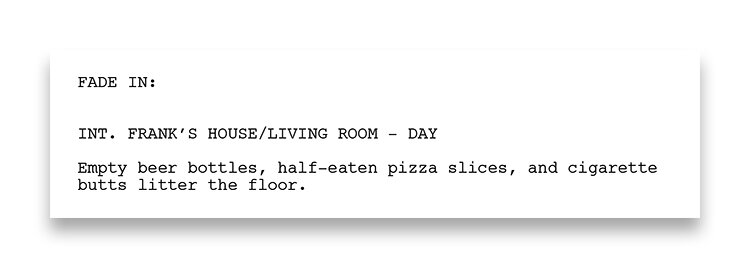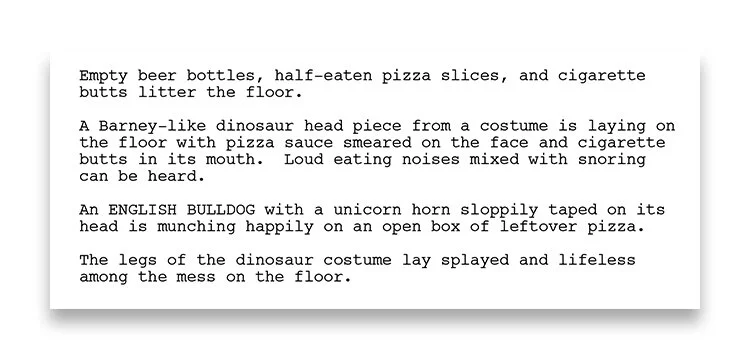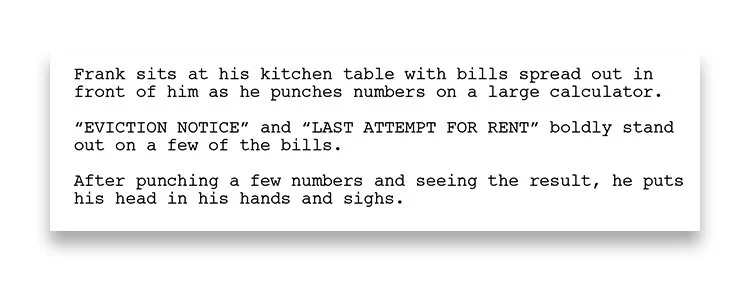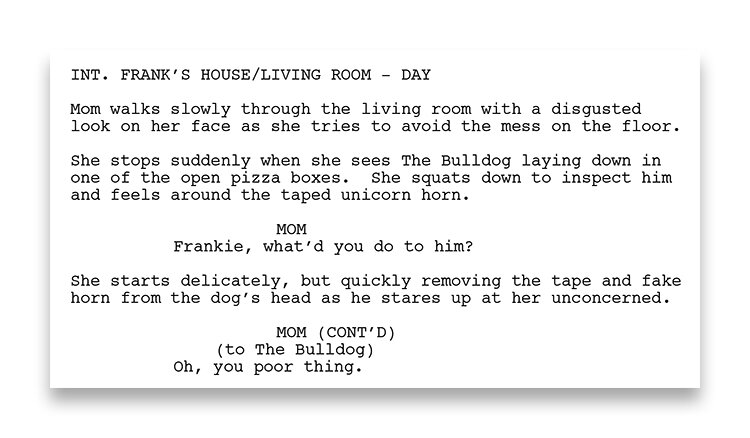
How to Write a Screenplay
The Basics
The information below is meant to be a general guideline on how to properly format a screenplay. Industry standards may vary slightly and many working screenwriters have different storytelling methods, but the basics outlined below should be a good start for anyone who has never written a screenplay.
What is a screenplay?
Do I need screenwriting software?
Spec Script vs. Shooting Script
Page Size
Margins
Spacing
Fonts
Page Numbering
Title Page
Only Write What the Audience Can See or Hear!
FADE IN:
Scene Headings
Action Lines
One Shot Per Paragraph
Character Introductions
Character Descriptions
Show, Don't Tell
Dialogue
Voice-Over & Off-Screen
Parentheticals
Transitions
Questions?
Tips: Read Produced Screenplays
Comments Section
What is a screenplay? How important is the format?
A screenplay is a blueprint for a film and offers the reader a chance to see the film play out in their head while they read. There are basic formatting rules for screenplays that are essential to learn if you hope to get your screenplay produced. It doesn't matter if you have an amazing story, a script that isn't formatted properly immediately jumps out as "unprofessional" to readers, producers, actors, and anyone that is accustomed to reading scripts as part of their profession. Getting a screenplay produced is tough enough without putting yourself at a disadvantage with an incorrectly formatted screenplay.
Do I need screenwriting software to write a screenplay?
No, but screenwriting software can take care of most of the basic formatting rules for you and includes many other helfpul tools. For free screenwriting software, check out Celtx or WriterDuet. If you don't mind spending money for software, Movie Magic* and Final Draft have a very good reputation in the industry. If you are familiar with markdown, a focused writing app like iA Writer* can be a viable alternative. Either way, do some quick research to find out what best fits your needs.
*Currently sponsoring the Screenwriting Challenge
Spec Script vs. Shooting Script
A "spec" script is a speculative screenplay which is written for the purpose of being optioned and produced. A "shooting" script is a screenplay that is used during the production of a film and is most commonly written by the director and/or cinematographer. Features such as scene numbering and camera direction (PAN UP, ZOOM IN, CRANE UP, etc..) are only used in shooting scripts and should not be used in spec scripts since the director and/or cinematographer will be making these decisions, not the writer. Though occasionally a writer may include some direction in a spec script, it is typically not recommended. All NYC Midnight screenwriting competitions are for "spec" scripts, not "shooting scripts".
Page Size
The standard page size for a screenplay is 8.5" wide x 11" high typed in portrait (not landscape).
Margins
The top, bottom, and right margins should be set at 1.0" and the left margin should be set at 1.5". When writing your screenplay, an approximate guideline for the different elements is below:
SCENE HEADING
1.5” Left Margin and 1.0” Right Margin
ACTION LINE(S)
1.5” Left Margin and 1.0” Right Margin
SPEAKING CHARACTER NAME
3.5” Left Margin and 1.0” Right Margin
LINE OF DIALOGUE
2.5” Left Margin and 2.5” Right Margin
PARENTHETICAL
3.0” Left Margin and 3.0” Right Margin
TRANSITION
6.0” Left Margin and 1.0” Right Margin
If you are writing your screenplay using industry accepted software, the margins will be taken care of for you and it's ok if they vary slightly from the measurements above.
Spacing
The standard spacing between the different elements of a screenplay is listed below:
SCENE HEADING & ACTION LINE(S)
Double
ACTION LINE(S) & ACTION LINE(S)
Double
ACTION LINE(S) & SPEAKING CHARACTER NAME
Double
SPEAKING CHARACTER NAME & PARENTHETICAL
Single
PARENTHETICAL & LINE OF DIALOGUE
Single
SPEAKING CHARACTER NAME & LINE OF DIALOGUE
Single
LINE OF DIALOGUE & NEXT SPEAKING CHARACTER NAME
Double
LINE OF DIALOGUE & ACTION LINE(S)
Double
TRANSITION & ALL ELEMENTS
Double
Fonts
The standard font for screenplays is 12 point in Courier, Courier New, or Courier Final Draft ONLY. All text should be black on the natural white background of the paper.
Page Numbering
Pages should be numbered in the upper right corner of the page, approximately 0.5" from the top margin and 1.0" from the right margin. The first page should NOT be numbered. The title page should not count as a page in your screenplay.
Title Page
For NYC Midnight competitions, only the title of the screenplay and logline should appear on the title page. The author's name should not appear on the title page or anywhere in the screenplay in order to keep the judging anonymous. That being said, if you plan on submitting your screenplay after the competition, make sure to follow the standard rules below.
Outside of our competitions, the title page should contain the title of the screenplay, the author's name, and contact information to get in touch with the author. Do not include any special fonts, illustrations, pictures, or additional information as it will immediately jump out as amateur to seasoned professionals in the industry. The title should be ALL CAPS and centered horizontally and vertically on the page with "Written by" triple spaced below the title, and the author's name or names double spaced below "Written by".
The contact information (email address, phone number) of the author or agent of author (depending on who is the primary contact) should appear in the bottom left hand corner of the page approximately 1.5" inch from the left margin and 1.0" from the bottom margin. While mailing address has traditionally been included with your contact information, many feel that including an email address and phone number is now sufficient. Here is an example of properly formatted title page:
In the United States it is recommended to get your work copyrighted and/or registered with the Writer's Guild of America (WGA West or WGA East), but it is not required to put this information on your title page or anywhere else in your screenplay. If you do decide to put your WGA registration numbers or copyright information on your title page (even though it is not common among professionals), it should be in the bottom right hand corner 1.0" from the right margin and 1.0" from the bottom margin.
Only Write What the Audience Can See or Hear!
You are almost ready to begin your screenplay, but make sure you remember this tip when writing! If you are not describing what an audience can see or hear, it does not belong in a screenplay. For example:
Since the audience will not be able to see that Frank wished he had a time machine based on how it is written above, you will need to revise this so the audience can hear that he wished he had a time machine through a voice over (designated as V.O. for voiceover and further described in the parentheticals section):
Now the audience will know that Frank wished he had a time machine through his voice over. Keeping this rule in mind when writing will make it very easy for the reader to visualize the film in their heads.
FADE IN:
When beginning your screenplay, the first thing to write is FADE IN: to signify the screenplay is about to start. While it is considered a transition, it is only used once at the opening, and is 1.5" from the left margin as opposed to all other transitions in the screenplay which are approximately 6.0" from the left margin. You will need to double space between FADE IN: and the next line in your screenplay.
Scene Headings
Each scene needs to have a scene heading which describes to the reader where and when it is taking place. Every time the location or time of day changes, a new scene heading is required. Scene headings are written in all CAPS. It includes three major elements:
Interior or Exterior (Written as INT. or EXT.)
Defines if the location is inside or outside. For example, a restaurant would be considered an Interior location (INT.) and a public park would be considered an Exterior location (EXT.).
Location (Written as MASTER SETTING/SPECIFIC SETTING)
Defines the location where the scene is taking place. It should define a master setting which is the main location such as a building, apartment, house, etc... and if necessary, any smaller, more specific locations within the master setting such as a kitchen, bathroom, living room, etc.. of a house (for example). A few examples of how the location is written are below:
INT. COFFIN
INT. POLICE STATION/HOLDING CELL
INT. FRANK'S HOUSE/LIVING ROOM
INT. FRANK'S HOUSE/BEDROOM
EXT. PUBLIC PARK
Time of Day (Written as DAY or NIGHT)
The last element to include in a scene heading is the time of day. You don't need to include the exact time, just whether it's during the DAY or NIGHT. This helps during the pre-production process as filmmakers need to know if they will depend on natural light or will have any specific lighting needs.
So, using all the elements above, here are a few examples of complete scene headings:
INT. COFFIN - NIGHT
INT. POLICE STATION/HOLDING CELL - NIGHT
INT. FRANK'S HOUSE/LIVING ROOM - DAY
INT. FRANK'S HOUSE/BEDROOM - NIGHT
EXT. PUBLIC PARK - DAY
Scene headings are left justified at 1.5" from the left margin and require a double space before starting a new action line. Here is an example of a scene heading at the beginning of a screenplay:
Action Lines
This is where you create the images of the film in the reader's head. As stated above, action lines should only describe what an audience can see or hear. They should be short and concise, easy to visualize, and should move the characters, and plot forward. Action lines should always be written in the present tense.
One Shot (or Action) per Paragraph
Typically, each shot or action requires it's own paragraph in a screenplay. Here is an example of how NOT to write an action paragraph:
This paragraph is way too clunky and includes several shots which should have their own paragraph. Below is a better way to pace it out:
You'll see that now each paragraph represents a shot and flows much easier for the reader. When describing the shot or introducing a character through your action lines, try not to exceed 4 action lines per paragraph for the sake of the reader. This rule varies slightly, but most are in agreement that the shorter the better.
Character Introductions in Action Lines
Characters are also introduced through action lines. Always put a character's name in ALL CAPS when introducing them for the first time in your screenplay. You don't need to keep them in caps throughout the screenplay, only the first time you introduce them to the reader. Animals, such as the ENGLISH BULLDOG above, need to be capitalized as well when first being introduced.
It's also important to briefly describe the character in the introduction so that it paints a better picture for the reader. What age range? Do they have important physical attributes that help define their character? A few examples of important attributes would be eyeglasses, a large scar on their face, morbidly obese, scrawny, in a wheelchair, tattoos, very carefully manicured, etc. Are they wearing something in particular that helps define their character such as a tuxedo or flip flops? An example of a character introduction is below:
Character descriptions are not necessary for minor characters if they don't add to the story. For example, a MALE SECURITY GUARD that makes an appearance in a single shot does not need 3 lines of description for his character unless it's vital to the story.
When introducing minor characters, such as the MALE SECURITY GUARD above, make sure to include #1, #2, and so on if you are using more than one of the same character. For example, if you will introduce another MALE SECURITY GUARD at a later time in the screenplay, make sure to refer to the first as MALE SECURITY GUARD #1 when you introduce them and continue to use that name throughout the screenplay.
Character Descriptions in Action Lines
Once you have introduced the characters, you don't need to continue to include their physical attributes unless it's important to the scene. But, it is important to convey the character's emotional state in most scenes so the reader sees his or her development throughout the story. The better you can describe the character's emotional state, the more the reader will be able to visualize it and get invested in the story. For example;
This description explains the scene but doesn't do a very good job of describing his emotional state. Here is a better description of his emotion:
Of course, there are infinite number of ways a writer can convey the story through their action descriptions, but remember that getting the reader caught up in the story through the emotion of the characters and descriptions of the scene is one of the most important aspects of screenwriting.
Show, Don't Tell
An age old adage in screenwriting (and creative writing for that matter) is that it is usually always better to communicate something through an image or images, rather than having a character explain it to the audience. Of course dialogue is necessary in most stories, but following this rule when possible will make for a more visual read and a more watchable film. For example:
While the writer is trying to get across to the audience that Frank is in debt and in a big predicament if he doesn't pay his rent, this isn't the best way to do it. It's not realistic for the character to be talking to himself about something that he already knows and will take most people out of the story immediately.
Don't underestimate your audience. By simply flashing an EVICTION NOTICE or LAST ATTEMPT FOR RENT letter lying next to his calculator in an action line (shown below), the audience immediately grasps that he is in deep financial trouble without having your character say a word.
Dialogue
When your characters speak, it is called dialogue and it is written in a specific way. First, you need to write the name of the character speaking in ALL CAPS approximately 3.5" from the left margin. Any Parentheticals (further described in the section below) are single spaced beneath the speaking character approximately 3.0" from the left margin. The dialogue is then inserted as a single space below approximately 2.5" from the left margin. Never center the dialogue on the page! It should always be left justified at the approximate margins listed above.
If there is more than one character speaking in the scene, you will need to identify each speaking character every time they speak. Speaking characters are double spaced. For example:
If the same character speaks through an action, you need to write (CONT'D) next to the character's name after the line of action. For example:
This is to let the filmmakers know that the speaking continues through the action and will most likely end up as one shot as opposed to several shots. As with most of the basics such as margins and spacing, CONT'D is taken care of automatically by most screenwriting programs.
Voiceover and Off-Screen
When a character is speaking in a scene but is not physically in the scene or not physically speaking in the scene, you need to designate the dialogue as either voice-over (V.O.) or off-screen (O.S.) which is placed on the same line as the speaking character's name in the dialogue.
If the character is physically present in the scene but is not visible during their dialogue (i.e. locked in the bathroom, hiding under the bed, etc..) then it needs to be designated as off-screen (O.S). If they are not physically present, such as acting as a narrator or speaking on the phone, then it should be designated as a voice-over (V.O.). Also, if the actor can be physically seen but you wish to have him/her communicating their thoughts or narrating to the audience without actually speaking in the scene, you will need to designate the dialoge as voice-over also (V.O.).
Parentheticals
Parentheticals are direction for the actors and are placed beneath the speaking character's name in the dialogue to express the actor's emotions or actions. As with any direction in a spec script, it should be minimal, so make sure to use parentheticals only when necessary.
Parentheticals are placed on their own line, in parenthesis (), single spaced below the speaking character's name, and approximately 3.0" from the left margin. They are typically only a few words, never a full sentence, and always in lower case. If you are using more than a few words to describe the emotion or action of the actor, you should be using an action line preceding the dialogue.
When you need to represent a brief pause in the character's speech, you should use the parenthetical (beat) between the lines of dialogue.
Some examples of parentheticals using emotion, action, and a brief pause are below:
Transitions
Direction for how one shot transitions in the next shot in your screenplay is called a transition. For example, "FADE IN:", the very first text in a screenplay, represents the very first shot of the film fading in from black (or another color). All transitions are double spaced and are approximately 6.0" from the left margin.
Popular transitions also include "DISSOLVE TO:" and "CUT TO:", even though "CUT TO:" is redundant since every shot cuts to another shot. "CUT TO:" is most commonly used for comedic or dramatic effect by alerting the reader to the contrast between the shots. For example:
The other important transition besides "FADE IN:" that needs to be included in your screenplay is "FADE OUT.", which represents the end of the film. There should be no further text beyond "FADE OUT." besides "THE END" which is double spaced and centered on the page. "THE END" is not necessary though, since "FADE OUT" designates the end of the screenplay as well. An example is below:
Questions, Comments, or Concerns?
While this article covers the basics, you may find that there are many topics and aspects of a screenplay not mentioned here. If you have any questions or comments regarding any aspect of the screenwriting process, please contact us, and we will do our best to get you an answer as soon as possible. You can also ask any questions in our Screenwriting forum to tap into the knowledge of thousands of writers in our community.
Other Tips: Read Produced Screenplays
Reading produced screenplays is a great way to learn the art quickly and see varying storytelling styles from some of the best writers in the business. Produced screenplays also have the benefit of a finished film to watch as well. Check out the website IMSDB.com (The Internet Movie Script Database) to download and read hundreds of classic and award winning films, including latest releases. Keep in mind you may see some of the top screenwriters breaking some of the rules mentioned above, but that's not an excuse to break the rules yourself. Until you have one or more multi-million dollar features under your belt, breaking the rules will only make it harder to be taken seriously by professionals that read scripts for a living. Thanks for reading and keep challenging yourself as writers!

















